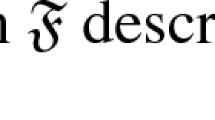Abstract
Within many approaches to the interpretation of quantum mechanics, especially modal interpretations, one singles out a particular decomposition of the state vector in order to fix the properties that are well-defined for the system. We present a novel proposal for this preferred decomposition. Given a distinguished factorization of the Hilbert space, it is the decomposition that minimizes the Ingarden–Urbanik entropy from among all product decompositions with respect to the distinguished factorization. We incorporate this choice of preferred decomposition into a framework for modal interpretations and investigate in detail the extent to which it provides a solution to the measurement problem and the extent to which it ensures that measurements whose outcomes are predictable with probability 1 reveal pre-existing properties of the system under investigation.
Similar content being viewed by others
REFERENCES
J. Bub, Interpreting the Quantum World (Cambridge University Press, Cambridge, 1997).
D. Deutsch,”Quantum theory as a universal physical theory,” Int. J. Theor. Phys. 24, 1 (1985).
W. H. Zurek, “Preferred states, predictability, classicality and the environment-induced decoherence,” Prog. Theor. Phys. 89, 281 (1993).
A. Kent and J. McElwaine, “Quantum prediction algorithms,” Phys. Rev. A 55, 1703 (1997).
D. Dieks and P. Vermaas, eds., The Modal Interpretation of Quantum Mechanics (Kluwer Academic, Boston, 1998).
R. Healey and G. Hellman, eds., Quantum Measurement: Beyond Paradox (University of Minnesota Press, Minneapolis, 1997).
R. W. Spekkens and J. E. Sipe, “Non-orthogonal preferred projectors for modal interpretations of quantum mechanics,” Found. Phys. 31(10) (2001).
J. Bub and R. Clifton, “A Uniqueness theorem for ‘no collapse’ interpretations of quantum mechanics,” Stud. Hist. Phil. Mod. Phys. 27, 181 (1996).
D. Bohm and B. J. Hiley, The Undivided Universe: An Ontological Interpretation of Quantum Theory (Routledge, London, 1993).
J. S. Bell, Speakable and Unspeakable in Quantum Mechanics (Cambridge University Press, Cambridge, 1993), Chap. 19.
S. Kochen, “A new interpretation of quantum mechanics,” in Symposium on the Foundations of Modern Physics, P. Lahti and P. Mittelstaedt, eds. (World Scientific, Singapore, 1985), p. 151.
D. Dieks, “The formalism of quantum theory: An objective description of reality?” Ann. Phys. 7, 174 (1988).
R. Healey, The Philosophy of Quantum Mechanics (Cambridge University Press, Cambridge, 1989).
A. Elby and J. Bub, “The triorthogonal uniqueness theorem and its relevance to the interpretation of quantum mechanics,” Phys. Rev. A 49, 4213 (1994).
R. Clifton, “The triorthogonal uniqueness theorem and its irrelevance to the modal interpretation of quantum mechanics,” in Symposium on the Foundations of Modern Physics 1994—70 Years of Matter Waves, K. V. Laurikainen et al., eds. (Editions Frontières, Paris, 1995), p. 45.
P. Vermaas and D. Dieks, “The modal interpretation of quantum mechanics and its generalization to density operators,” Found. Phys. 25, 145 (1995).
G. Bacciagaluppi and M. Dickson, “Dynamics for modal interpretations,” Found. Phys. 29, 1165 (1999).
D. Dieks, “Preferred factorizations and consistent property attribution,” in Healey and Hellman,(6) p. 144.
P. E. Vermaas, “A no-go theorem for joint property ascriptions in modal interpretations of quantum mechanics,” Phys. Rev. Lett. 78, 2033 (1997).
G. Bacciagaluppi, M. J. Donald, and P. E. Vermaas, “Continuity and discontinuity of definite properties in the modal interpretation,” Helv. Phys. Acta 68, 679 (1995).
G. Bacciagaluppi and M. Hemmo, “Modal interpretations, decoherence and measurements,” Stud. Hist. Phil. Mod. Phys. 27B, 239 (1996).
P. Vermaas, “The pros and cons of the Kochen–Dieks and the atomic modal interpretation,” in Dieks and Vermaas,(5) p. 103.
G. Bacciagaluppi and M. Hemmo, “State preparation in the modal interpretation,” in Healey and Hellman,(6) p. 95.
G. Bacciagaluppi, “Kochen–Specker tfheorem in the modal interpretation of quantum mechanics,” Int. J. Theor. Phys. 34, 1205 (1995).
R. S. Ingarden and K. Urbanik, “Quantum informational thermodynamics,” Acta Phys. Pol. 21, 281 (1962).
A. Peres, “Higher-order Schmidt decompositions,” Phys. Lett A 202, 16 (1995).
J. Vink, “Quantum mechanics in terms of discrete beables,” Phys. Rev. A 48, 1808 (1993).
D. Z. Albert, Quantum Mechanics and Experience (Harvard University Press, Cambridge, 1992).
A. Peres, Quantum Theory: Concepts and Methods (Kluwer Academic, 1995).
R. Omnès, The Interpretation of Quantum Mechanics (Princeton University Press, Princeton, 1994), pp. 306–309.
L. P. Hughston, R. Jozsa, and W. K. Wootters, “A complete classification of quantum ensembles having a given density matrix,” Phys. Lett. A 183, 14 (1993).
R. Bhatia, Matrix Analysis (Springer, New York, 1997).
M. A. Nielsen, “Conditions for a class of entanglement transformations,” Phys. Rev. Lett. 83, 436 (1999).
Author information
Authors and Affiliations
Rights and permissions
About this article
Cite this article
Spekkens, R.W., Sipe, J.E. A Modal Interpretation of Quantum Mechanics Based on a Principle of Entropy Minimization. Foundations of Physics 31, 1431–1464 (2001). https://doi.org/10.1023/A:1012630429527
Issue Date:
DOI: https://doi.org/10.1023/A:1012630429527




